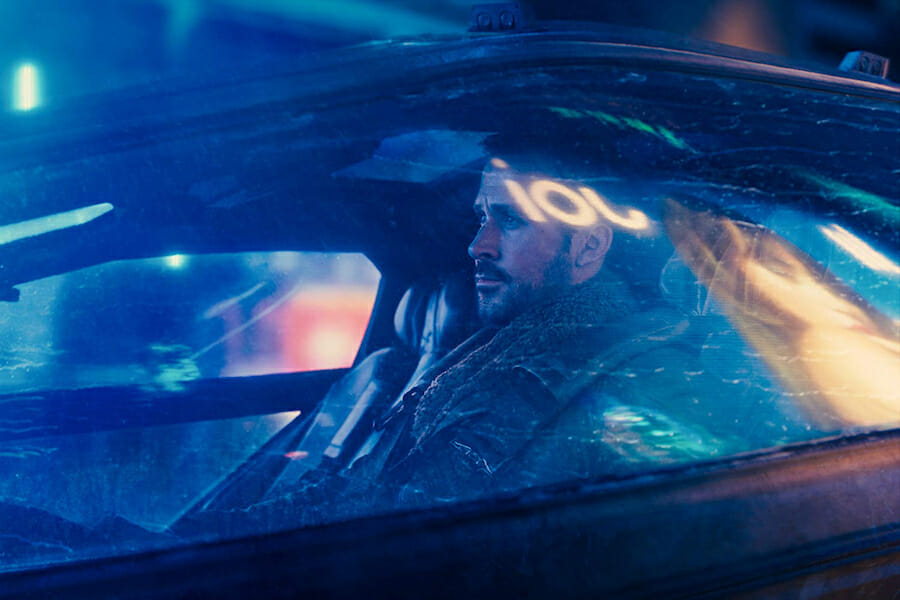
Gender & Politics in ‘Blade Runner 2049’
The last few years have seen a marked acceleration in social change; real, imagined and discussed. This time will be remarked upon in the future as an identifiable period of tumult, rather like 1968. But the precise character of our period is less easy to identify, especially as it is now dominated by conflict between competing movements.
Each movement is at risk of being defined by its opponents, and these hostile definitions often attempt to write the opposition off as being extremist movements. In this way, many online ‘progressive’ activists will react to any opponent to their views by classing them in with the ‘alt-right,’ while many ‘conservative’ keyboard warriors react to any feminist ideas as if they are a personal attack by little more than a cult member.
In truth, once we recognize that there is a ‘conservative’ and a ‘progressive’ movement, it becomes possible to identify their characteristics. We can then perceive these characteristics in many different places, people, and media, and most importantly perceive that they are arising naturally, or spontaneously, from the imagination, needs, desires and subconscious in the ocean of humanity.
Blade Runner 2049 provides many manifestations of these characteristics, without being aligned with any particular side. This is one of the highest functions of art; to reveal the concerns of society when those things are so obscured by political factionalism that they have become invisible.
2049 creates an atmosphere which pulls the viewer deeply into its world aided by the dark synth instrumentation and daring, impressive art and visuals. Aiding this atmosphere is the archetypal nature of many of its characters. They resemble the stark figures of myth. This works because the main figures are replicants or holographic AI; we have a plausible excuse for a lack of human ‘development.’ Instead, the many subtleties and implications within the film hint at deeper meanings in the story itself, and the world that is revealed to us. By looking at these figures, we can approach the themes of the film.
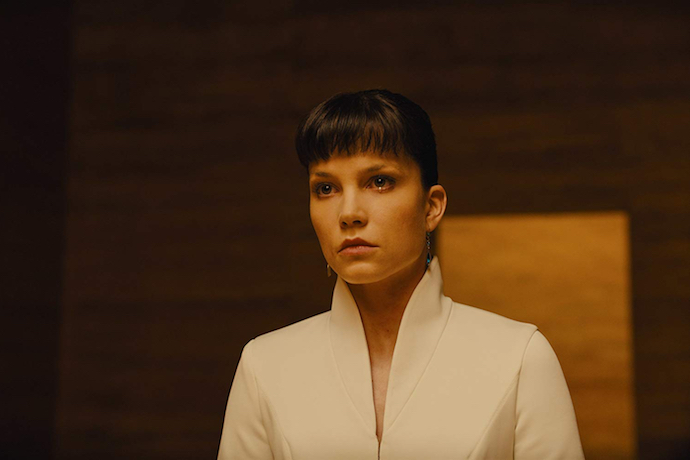
Luv & the Professional Woman
One of the most striking things about 2049 is the repetition of character roles from the original Blade Runner. Both films have a male detective-hero central character, a sinister and very powerful male corporate director, a prominent female ‘assistant’ character to this director, an artificial love interest and an immediate professional superior to the detective. The fact that the roles repeat underlines their archetypal character, while the differences between the characters that fill the repeating roles are very revealing.
The ‘female assistant’ to a corporate director is, in both films, one of the most important figures. The fact that this position recurs, together with the archetypal feel of the characters in the films, makes it tempting to take Rachel in Blade Runner, and Luv in 2049 as representing something — say, women becoming part of the corporate world, or the professional woman, and other themes tangential to this. The first thing that is underlined is a male reaction to this phenomenon, because both films revolve around a male central character. In the original, he desires her — in 2049, he rejects her. On a basic level this represents a modern ‘trad’ rejection of the career woman in favour of the housewife.
Both characters however are sophisticated and remarkable in their own right. In the original, Rachel is internally one of the deepest and most sympathetic characters — she goes through the most intensely existential and human process — of questioning her own internal reality, affirming it, then rebelling against her creator/corporate owner. In 2049, the assistant character instead has darkly embraced all of what her role means; she has embraced the moral and existential system that created and controls her, just as the years since the original film have seen women in general embracing and becoming part of — leading, in several cases — the systems that feminism initially criticized. This process is equally human, but is portrayed as negative.
Therefore Luv exemplifies corporate power most directly; in one of the most memorable scenes, she aims and directs missiles on dozens of ragged wasteland-dwellers as she reclines, Empress-like and manicured. She directly copies her creator/owner, emulating his kiss of his earlier victim as she leaves K to die in the sea; as she swaggers away from him, maintaining eye contact, she whispers, “I’m the best one.” She cares about her position in the hierarchy, and cares about the hierarchy itself. Yet, in the archives, she also very subtly makes a pass at K. This, like many of 2049’s characterizations, is done to show that the replicant characters are not robots, but humans. An underlying statement, again somewhat neo-traditional in nature, is to portray sexuality and desire — ultimately embodied in heterosexual reproduction — as integral to being human.
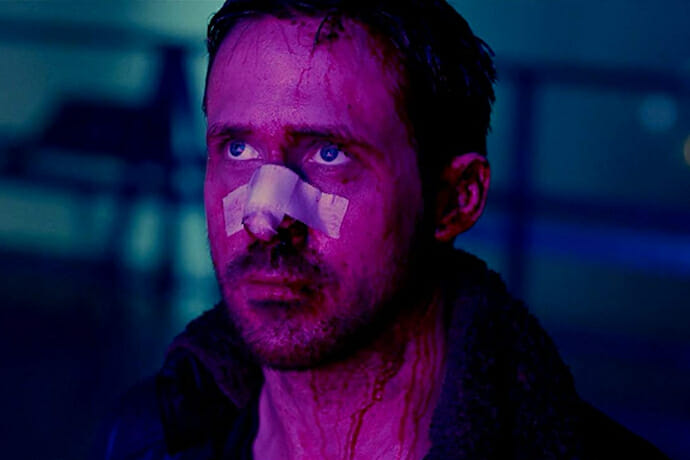
K & the Hero
Ryan Gosling’s character, K, underlines the attributes of his previous character, the Driver in the 2011 hit film. Drive prefigured the conservative aesthetic and emotions that were to arise in the following years, and K echoes this aesthetic and these emotions. The archetype of both characters is that of a hero, with some important aspects of the hero narrative changed.
Both of these hero stories are archetypal in the sense of self-sacrifice for a higher good, personalized in a female. But they are specific to our times in the self-effacement each of the characters endure. Instead of the hero enjoying a happy ending that intertwines with evolutionary psychology —i.e through his heroic actions, he saves and attracts a partner and secures the future — the hero secures no happy ending and leaves no descendants. This aspect is specifically negated in Drive, as Gosling’s character cares for and saves another man’s son — and never sleeps with the woman who he loves and who loves him. In 2049 meanwhile, K’s hopes and dreams — that he is a being with a soul, of woman born, are crushed. His final actions, saving the life of Deckard, may even hinder the struggle that is his last cause — the replicant rebellion. In both films, the hero does what is right, because he knows that it is right inside, and is rewarded with internal integrity, peace and satisfaction — fundamentally a spiritual reward. This aspect of the modern hero is perhaps co-created by Gosling’s acting talents and choices as well as the writers and directors behind the films.
Gosling’s influence may even have erased part of the intent of the writers. K’s replicant name, together with his chosen name, Joe, are probably references to the central character in Franz Kafka’s The Trial and The Castle, Josef K.. Kafka’s books describe an authoritarian-bureaucratic world in which the individual is continually crushed and confused by a nightmarish, labyrinthine hierarchy and bureaucracy around him. There are elements of this within 2049, most notably the ‘baseline test,’ but K fundamentally radiates inner peace and confidence in the face of his oppression — a found humanity which represents freedom, even under the most extreme control.
The conservative aesthetic in both films comes across in a strongly pre-existing, or natural, male role. There is no internal doubt about what the characters should do — and yet their duty is one that most people would reject. The self-assured ease with which the Driver and K take on their duties — of protecting an involved woman and child, or of performing thankless, dangerous work within a hierarchy, is a reproach to the rejection of responsibility. This along with the self-contained attitude of internal integrity offers an appealing solution to many of the crises that early 21st-century man experiences himself as facing.
The ways this conservative aesthetic and morality intersect with a progressive aesthetic and morality can be seen when comparing the hero of the original Blade Runner with 2049. Ford’s character in the original is a fairly classic male for both Ford roles and 80s action movie roles. He is highly independent, gruff and cynical, assertive and dominant with women, though caring, and perhaps represents a kind of symbol of what a ‘grown-up’ relationship with a man is like. The charisma and charm of Ford himself probably turned his roles from being classic ‘sexist’ examples of 70s-80s cinema into being a figure of desire, even for many feminists.
K and Gosling himself, as examples of men, are very different. K is externally quiet, and if not submissive then far less dominant, and certainly very attentive. This illustrates a progressive change and accommodation to the increased female presence and power in the external world. His masculinity is one which is managed and controlled, and is dutiful rather than spontaneous. The meeting of K and Deckard illustrates many of these elements, Deckard wanting to fight immediately and yet easily yielding — the old masculine sub-archetype of ‘swift in anger and quick to laugh.’
Furthermore, while Deckard, the classic boomer father, has to an extent orientated his life around Rachel and their child, it is an orientation in absentia; Deckard has maintained his independence. K meanwhile is more wholly orientated towards the female; he is initially completely under the command of a woman, has an AI waifu at home, and finds that his story is a sub-plot in the triumphant emergence of a sacred woman.
K, the Driver, and Gosling’s feminism, as well as their traditionalism, can be summed up by a real-life quote from Gosling himself: “I don’t think anyone can teach you how to be a man but a woman. You only learn by learning what they need.”
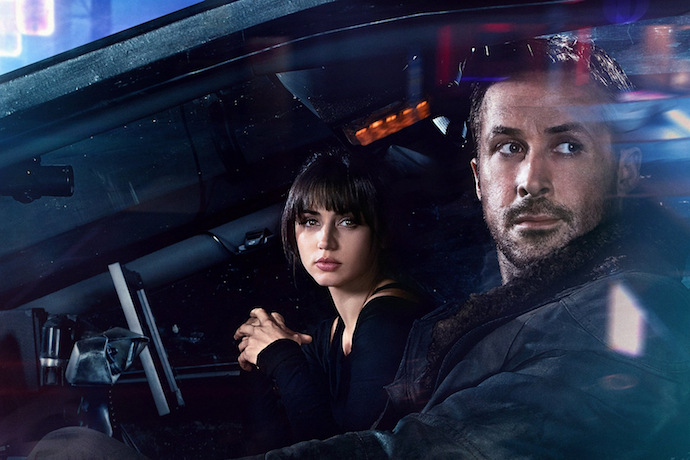
Joi & the Romantic Partner
Joi is the simplest example of an element of the film that is both conservative and progressive at the same time. As we have already mentioned, as a desired and loved being she is a positive representation of the housewife — but as a strictly bound, limited and imprisoned being she is a negative representation of the housewife. Neither of these representations are superficial.
She also illustrates 2049’s take on artificial life simply and directly. There is no doubt in her portrayal that she has a fully conscious human mind; this is continually demonstrated after the initial scene (which admittedly implies something different). This is also not a surprise to the other characters — it does not appear unusual. Replicants are also represented in this way. She appreciates and desires more freedom, although within meek, self-contained bounds, rather like K.
The inclusion of such a character is highly appropriate and topical due to the headlines made by Sexbots, A.I. and virtual girlfriends in 2017. 2049 again bridges a gap between two opposing camps, which could be simplified as a), Sex bots or girlfriend AIs are good, and will be made, or b), they are bad, because for instance they allow men to ‘misuse’ them with no penalty, and therefore will have an antisocial impact. 2049 portrays this figure positively, makes her nature human rather than that of a slave, and makes K the perfect attentive partner who would never dream of abusing his waifu.
Those interested in the psychological reality of archetypes may find it interesting to compare Joi to psychologist Carl Jung’s Anima; a female counterpart to a male ego who is ever-present, residing within the unconscious. Joi is always with K, travels with him, speaks to only him . Even her countenance exists ‘out there’ deep within the data banks.
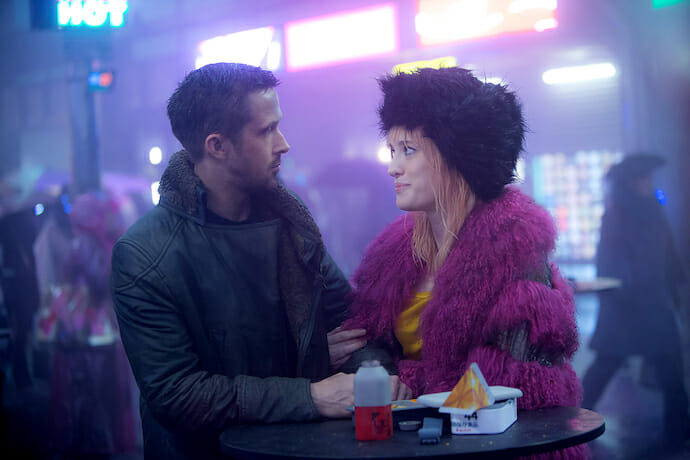
Mariette & the Prostitute
In the original film we have an obvious, though visceral and well-done, example of a prostitute — one of the four escaped replicants — who, it is assumed, has been brutalized and has suffered in her pre-programmed, pre-assigned life of sexual slavery, and has violently rebelled against her design and experience.
In 2049, the prostitute instead is part of a secret rebel movement — not a desperate, doomed, murderous fight for survival, like that of the replicant rebels in the original, but a planned, motivated, underground, and spiritual movement. Her status as a prostitute has been assumed as being of force or design in several feminist reviews — “Not only are the female stars presented by the filmmakers as objects of the male gaze, but within the story, they play machines explicitly designed, manufactured and programmed to service the desires of the male characters” (Richard Trenholm, CNET) — and yet it is equally possible that that is the position she has been assigned, or has chosen, in the operations of the rebel movement.
Furthermore, this movement is motivated almost solely by the miraculous birth of a replicant child. Thus, they would conceive of sex between replicants as a holy act with the potential for creating more life. This character’s sex with K, as well as being empathic on behalf of Joi, is therefore an act of hope and belief, a sacred indoctrination — into the sexual, life-creating world — of a virgin male, as well as being strategically necessary to plant a tracking device. The ‘jealous’ interaction between Joi and Mariette the morning after, also criticised ideologically, would then be understood to be frustration on the part of Mariette that a ‘lower’ form of life, a hologram incapable of the potential for life-creation, should hold all of K’s affection and love. These motivations for this character are made clear in the decisions of both the director and the actress.
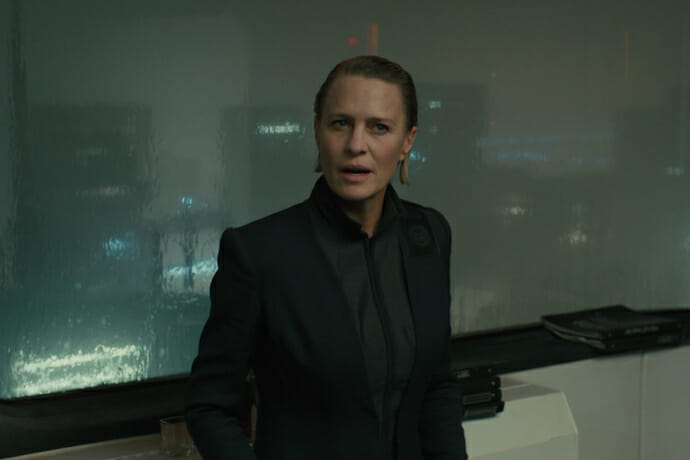
Madam Joshi & the Police Superior
Madam Joshi is another repeating character; the immediate superior to the detective in the police hierarchy. In the original film we had a fairly classic cynical, fat police superior straight out of a film noir. Madam Joshi is competent, intelligent, driven, a hard-ass who is open to softer emotions. The progressive statements are fairly obvious; there is a change from a male to a female superior, and this change is also accompanied by the character becoming apparently much better at the job.
In contrast, in 2049 the character and the police force itself are a hundred times more Kafkaesque or Orwellian. The institution is less humanized after the inclusion of women. Another conservative statement is on sexual difference; Joshi makes a pass at K at one point in the film, which K simply brushes off. Despite the fact that Joshi is K’s superior — and indeed she has power over his life and death — we see no real discomfort or coercion in this scene.
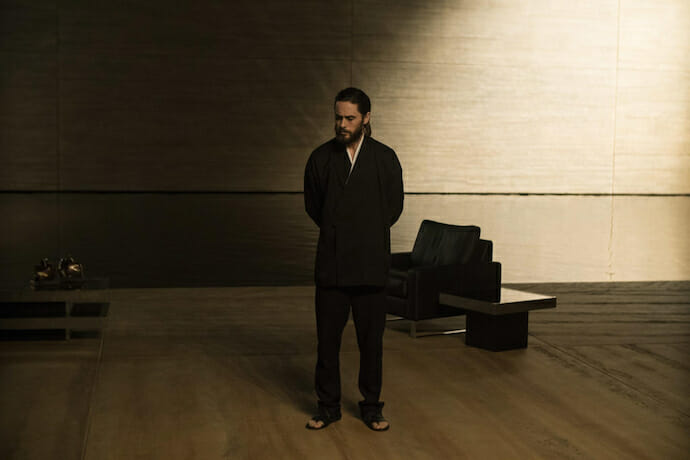
Wallace and the Corporate Director
We will just briefly touch on this character, as he does not really expand on the themes of this article. As the corporate director he represents power and hierarchical human intention. Interesting differences we see over the original Corporate Director are that he is considerably more powerful, more sinister and far better protected. Despite the fact that Blade Runner influenced Will Gibson’s novel Neuromancer to a remarkable extent, in this area Neuromancer was ahead of the game; corporate power in that world is portrayed as ever-present, god-like, transcendent in its ability to know and to act. 2049 admirably rectifies that lack in Blade Runner — while in the original the Hero, Deckard (and the replicant anti-Hero) are men whose powerful 20th-century individuality allows them to run rings around a dumb ‘system.’ In 2049 the hero has no such power; he can at most temporarily dodge the corporate hand, and needs help to do even that.
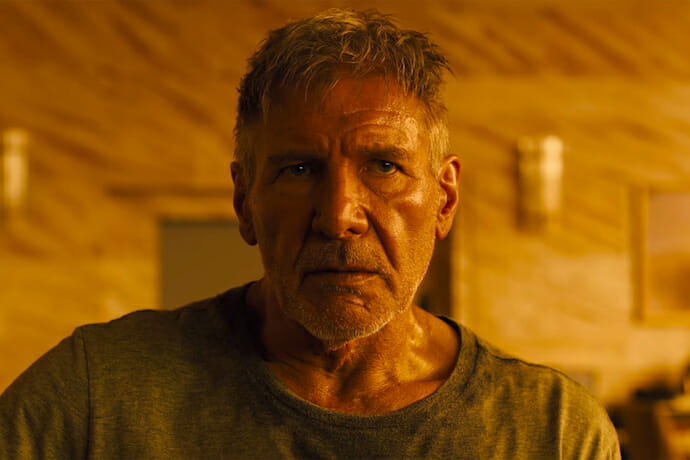
Humans
Mariette, the rebel-prostitute, describes replicants as ‘more human than humans,’ if a child can come from them. This sentiment is apparently shared by the writers and directors, as humans are portrayed in an almost scornful way throughout the film. With just a handful of exceptions, adult human portrayal fits within the following categories:
There’s the pathetic assistant (small beta-male) : the police lab assistant who Luv kills, and the receptionist-assistant at Wallace Corporation who is swiftly and directly deferential to Luv. Then there’s the faceless police officer or corporate enforcer, who have a common neo-fascist aesthetic throughout the film, displaying skinheads and vicious, frustrated aggression against replicants. There’s also the underworld tradesperson, a classic sleazy street-economy character, straight out of the original Blade Runner and Neuromancer.
Lastly, there’s the human savage — the inhabitants of K’s apartment block, and the dwellers in the wasteland. These subcategory humans represent a general degradation of humanity; they have either compromised dignity or compromised morality.
To look at the film as a broad narrative, its initial theme is that of the individuation or ‘coming to terms with himself’ of the hero. But the themes diverge — the intention of The Director, Wallace, is to create slaves which can reproduce, magnifying production. The counter-force to his evil is not the hero, but a simultaneous movement of freed slaves who want to discover the secret of reproduction in order to truly become free. The ancient symbol of the divine marriage is thus the conservative heart of the film; the fact that its messianic sacred child is a female is its progressive counter-stroke. However, this feminism is prophetic, spiritual or traditional, entirely separate from early-21st century 3rd-wave dogma.
What would the character of this female messiah be, if it were explored in a sequel? We may never find out; the box office figures for 2049 could deny it a sequel, and the search for, or gradual emergence of, the Divine Feminine will continue in silence, just as the struggle of modern man for meaning and purpose will continue in silence.

